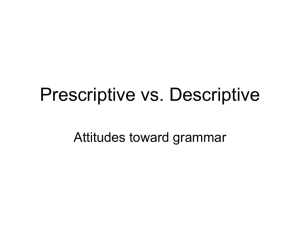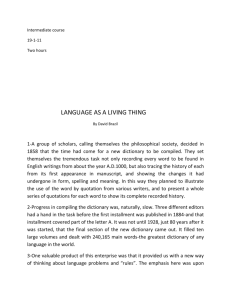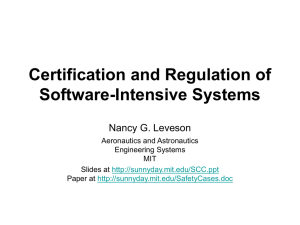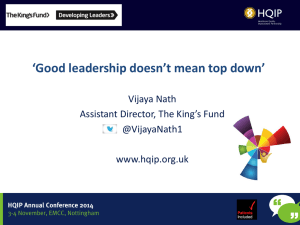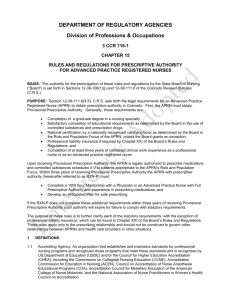Organizational_Culture
advertisement
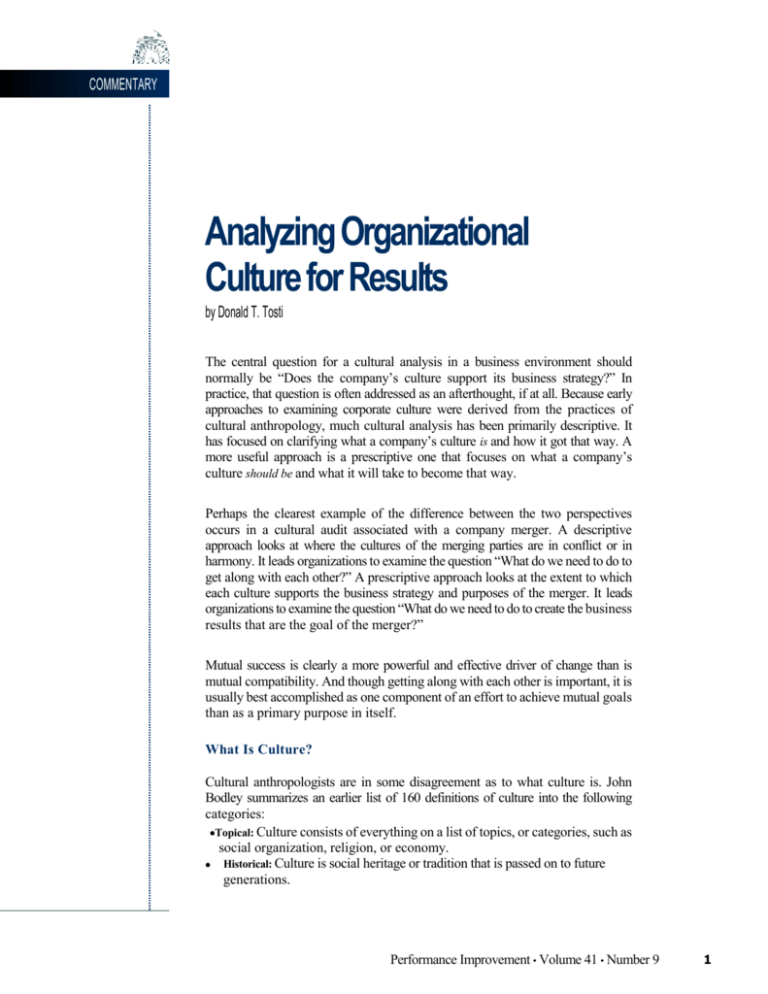
COMMENTARY Analyzing Organizational Culture for Results by Donald T. Tosti The central question for a cultural analysis in a business environment should normally be “Does the company’s culture support its business strategy?” In practice, that question is often addressed as an afterthought, if at all. Because early approaches to examining corporate culture were derived from the practices of cultural anthropology, much cultural analysis has been primarily descriptive. It has focused on clarifying what a company’s culture is and how it got that way. A more useful approach is a prescriptive one that focuses on what a company’s culture should be and what it will take to become that way. Perhaps the clearest example of the difference between the two perspectives occurs in a cultural audit associated with a company merger. A descriptive approach looks at where the cultures of the merging parties are in conflict or in harmony. It leads organizations to examine the question “What do we need to do to get along with each other?” A prescriptive approach looks at the extent to which each culture supports the business strategy and purposes of the merger. It leads organizations to examine the question “What do we need to do to create the business results that are the goal of the merger?” Mutual success is clearly a more powerful and effective driver of change than is mutual compatibility. And though getting along with each other is important, it is usually best accomplished as one component of an effort to achieve mutual goals than as a primary purpose in itself. What Is Culture? Cultural anthropologists are in some disagreement as to what culture is. John Bodley summarizes an earlier list of 160 definitions of culture into the following categories: Topical: Culture consists of everything on a list of topics, or categories, such as social organization, religion, or economy. Historical: Culture is social heritage or tradition that is passed on to future generations. Performance Improvement • Volume 41 • Number 9 1 Behavioral: Culture is shared, learned human behavior, a way of life. Normative: Culture is ideals, values, or rules for living. Functional: Culture is the way humans solve problems of adapting to the environment or living together. Mental: Culture is a complex of ideas, or learned habits, that inhibit impulses and distinguish people from animals. Structural: Culture consists of patterned and interrelated ideas, symbols, or behaviors. Symbolic: Culture is based on arbitrarily assigned meanings that are shared by a society. The definitions are not mutually incompatible, but the behavioral definition provides the best starting point for performance-based cultural analysis. In a business environment, however, the goal is not simply to describe typical behavioral practices now, but to describe the behavioral practices needed for success in the future and to determine how to encourage and support those practices. Cultural Analysis: Descriptive Versus Prescriptive Differences between the descriptive (anthropological model) and the prescriptive (performance model) approaches to cultural analysis may be seen in the types of questions used in data gathering. Descriptive approaches tend to use inferential questions such as, What values and beliefs do people share in this organization? What stories do people tell to help others understand how things work around here? Who are the heroes? In contrast, prescriptive approaches usually ask more direct questions: What kinds of practices do we need to demonstrate to be successful? How well are we doing those things now? What common practices do we have to change? The descriptive approach relies heavily on social norms and cultural profiles. The prescriptive approach focuses on outcomes, what is required to achieve valued results. Prescriptive Analysis The prescriptive approach looks at four critical areas. Its primary aim is to define the culture that will support the company’s strategy and contribute to long-term success. But it is also necessary to get some idea of where the organization is today in these areas. While the focus is on what should be, we also need to know something about what is. The following questions are helpful in such an analysis. Success Priorities: What do people believe are the key practices that will contribute to the company’s success over the long term? What do they believe it might take to be successful in the organization’s business environment and to create value for the organization’s stake- 2 www.ispi.org • OCTOBER 2002 holders with a new business focus? Determining these success practices is the key to understanding what it will take to meet the new business demands. Power and Influence: What are the practices that provide influence and control in the organization (as is and should be)? Where does decisionmaking authority reside? How are decisions tested? How much challenge is permitted or encouraged? How are rewards, recognition, intimidation, and/or fear used to influence behavior? Collaborative Relationships: How is teamwork legitimized and supported? How do cross-functional working relationships work? How is consensus defined? How does the organization measure or recognize both within-group and cross-group goals? What are the ground rules for cross-functional working relationships? Are some groups of employees considered more valuable or important than others? Basic Human Values: How do people signal respect (or disrespect) for each other? How and to what extent are such values as trust, commitment, or openness demonstrated? How is feedback delivered—does it tend to be given as advice about how to improve in the future or as criticism of what has been done in the past? Though this area is not tied as directly to results as the preceding ones, it is often the most visible and obvious component of culture for most people. It tends to contribute broadly to employee satisfaction and loyalty and is usually the greatest source of dissatisfaction and distraction for people when it is not the right way. In summary, then, the prescriptive approach to organizational culture does not depend on an up-front cultural profiling model but begins with business requirements and works back from these to establish a supportive culture. The organization’s cultural practices must be aligned to support creating valued results, that is, value for the company, its customers, its employees, and its stakeholder groups. Though the methods are quite different, the broad approach to conducting a cultural analysis is similar to that for conducting a process analysis—first establish the outcomes and then determine what is required to achieve them. Managers have typically recognized that it is their responsibility to ensure that company processes are aligned to produce results, but they have generally abdicated their role in aligning company practices to produce results. The prescriptive cultural audit is designed to establish the behavioral practices that will contribute to producing business results and to determine the extent to which people in the organization (or organizations, in the case of a merger) currently demonstrate those practices. The resulting clarity provides managers with a foundation for meeting the challenge of ensuring cultural alignment within and between business units focused on achieving the organization’s mission and vision. Related Readings Bodley, J. (1997). Cultural anthropology: Tribes, states, and the global system. Mountain View, CA: Mayfield Publishing Company. Tosti, D. (2000). Systemic change. Performance Improvement, 39(3), 53-59. Tosti. D., & Jackson, S. (1997). Customer value. San Rafael, CA: Vanguard Consulting. Tosti, D., & Jackson, S. (1994). Organizational alignment: How it works and why it matters. Training Magazine. Tosti, D., & Stotz, R.(2001). Building your brand from the inside out. Marketing Management. Tosti, D., & Stotz, R. (2000). Internal branding: Using performance technology to create an organization focused on customer value. Performance Improvement, 39(9), 5-11. Donald Tosti is the founder and managing partner of Vanguard Consulting. Don has an extensive and varied background in behavioral technology, and he has been a recognized expert in performance-based approaches to organizational change for over three decades.Don’s pioneering work on contingency management began in the 1960’s.Later as principle investigator for the multi-media leadership/management courses conducted for the US Naval Academy, he adapted the methods of performance analysis to the study of leadership and management behavior.His subsequent work centered on modifying behavioral norms and cultural values. Since the late 70s, Don has focused on organizational alignment and the development of Performance-Based Management Systems. He has been involved in a wide range of organizational change programs for companies in the United States and Europe. These consulting activities in organizational alignment include work in leadership, management, culture change, internal marketing and strategic alliances. Don has broad experience with changing organizational cultures to focus on creating greater customer value.Toward that end, he has developed survey instruments designed to measure factors that impact customer value and customer retention.He has worked with several clients to help them translate their “brand promise” into specific performance at the customer interface.Don may be reached at Change1 11 @aol.com. Performance Improvement • Volume 41 • Number 9 3

